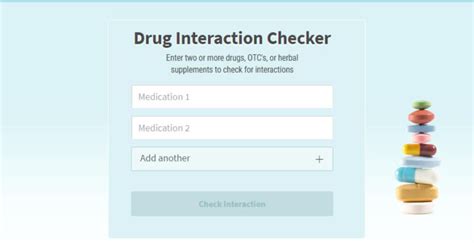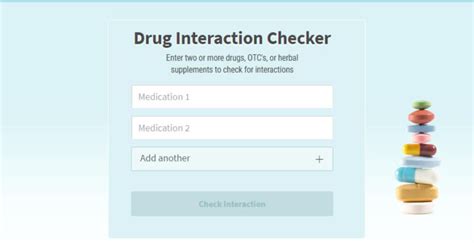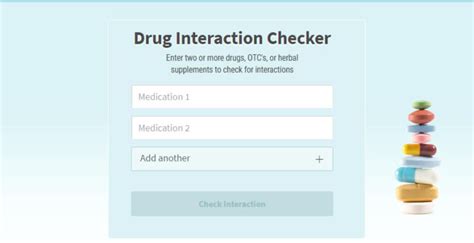Intro
Check medication interactions safely with our tool, avoiding adverse drug reactions and ensuring safe prescriptions by analyzing potential side effects, dosage, and contraindications.
The importance of medication interaction checker tools cannot be overstated, especially in today's complex healthcare landscape. With the rise of polypharmacy, where patients take multiple medications simultaneously, the risk of adverse interactions has increased significantly. According to a study, nearly 70% of adults in the United States take at least one prescription medication, and more than 50% take two or more. This has led to a growing concern about the potential risks associated with medication interactions. As a result, healthcare professionals and patients alike are turning to medication interaction checker tools to ensure safe and effective treatment.
The consequences of medication interactions can be severe, ranging from mild side effects to life-threatening conditions. For instance, a patient taking a blood thinner and a nonsteroidal anti-inflammatory drug (NSAID) may be at risk of bleeding due to the interaction between the two medications. Similarly, combining certain antidepressants with other medications can increase the risk of serotonin syndrome, a potentially life-threatening condition. It is crucial, therefore, to have a reliable system in place to identify potential interactions and prevent adverse reactions.
The development of medication interaction checker tools has been a significant step forward in addressing this issue. These tools use advanced algorithms and comprehensive databases to analyze medication regimens and identify potential interactions. By providing healthcare professionals and patients with accurate and timely information, these tools can help prevent adverse reactions, improve treatment outcomes, and enhance patient safety. In this article, we will delve into the world of medication interaction checker tools, exploring their benefits, working mechanisms, and key features.
What is a Medication Interaction Checker Tool?

Key Features of Medication Interaction Checker Tools
Some of the key features of medication interaction checker tools include: * Comprehensive databases of medications, including prescription and over-the-counter drugs, as well as herbal supplements and vitamins * Advanced algorithms that analyze medication regimens and identify potential interactions * User-friendly interfaces that allow healthcare professionals and patients to easily input medication information and receive results * Customizable alerts and notifications that warn of potential interactions and provide recommendations for alternative treatments * Integration with electronic health records (EHRs) and other healthcare systems to streamline workflow and improve patient careBenefits of Medication Interaction Checker Tools

How Medication Interaction Checker Tools Work
Medication interaction checker tools work by analyzing a patient's medication regimen and identifying potential interactions between medications, as well as between medications and other factors such as food, drinks, or medical conditions. The process typically involves the following steps: 1. Data input: The patient's medication regimen is input into the system, either manually or through integration with an EHR or other healthcare system 2. Analysis: The system analyzes the medication regimen using advanced algorithms and comprehensive databases to identify potential interactions 3. Results: The system provides results, including a list of potential interactions and recommendations for alternative treatments 4. Review and revision: The healthcare professional reviews the results and revises the medication regimen as necessary to minimize interactions and ensure safe and effective treatmentTypes of Medication Interaction Checker Tools

Choosing the Right Medication Interaction Checker Tool
Choosing the right medication interaction checker tool depends on several factors, including the specific needs of the healthcare organization or patient, the level of integration required, and the desired features and functionality. Some of the key considerations include: * Comprehensive database: The tool should have a comprehensive database of medications, including prescription and over-the-counter drugs, as well as herbal supplements and vitamins * Advanced algorithms: The tool should use advanced algorithms to analyze medication regimens and identify potential interactions * User-friendly interface: The tool should have a user-friendly interface that allows healthcare professionals and patients to easily input medication information and receive results * Customizable alerts: The tool should provide customizable alerts and notifications that warn of potential interactions and provide recommendations for alternative treatmentsBest Practices for Using Medication Interaction Checker Tools

Common Challenges and Limitations
While medication interaction checker tools are highly effective, there are common challenges and limitations that healthcare professionals and patients should be aware of, including: * Data quality: The accuracy and completeness of the medication regimen data input into the system can affect the accuracy of the results * Database limitations: The comprehensiveness and accuracy of the medication database can affect the ability of the tool to identify potential interactions * Algorithm limitations: The advanced algorithms used by the tool can be limited by the complexity of the medication regimen and the availability of dataFuture Developments and Trends

Conclusion and Final Thoughts
In conclusion, medication interaction checker tools are a vital component of modern healthcare, providing healthcare professionals and patients with the information and insights needed to ensure safe and effective treatment. By understanding the benefits, working mechanisms, and key features of these tools, healthcare professionals and patients can make informed decisions about treatment and minimize the risk of adverse interactions. As the healthcare landscape continues to evolve, it is likely that medication interaction checker tools will play an increasingly important role in promoting patient safety and improving treatment outcomes.What is a medication interaction checker tool?
+A medication interaction checker tool is a software application or online platform that analyzes a patient's medication regimen to identify potential interactions between medications, as well as between medications and other factors such as food, drinks, or medical conditions.
How do medication interaction checker tools work?
+Medication interaction checker tools work by analyzing a patient's medication regimen and identifying potential interactions between medications, as well as between medications and other factors such as food, drinks, or medical conditions. The process typically involves data input, analysis, results, and review and revision.
What are the benefits of using medication interaction checker tools?
+The benefits of using medication interaction checker tools include improved patient safety, enhanced treatment outcomes, increased efficiency, and better patient engagement. By identifying potential interactions and preventing adverse reactions, medication interaction checker tools can help reduce the risk of medication-related harm and promote better health outcomes.
We hope this article has provided you with a comprehensive understanding of medication interaction checker tools and their importance in modern healthcare. If you have any further questions or would like to share your experiences with medication interaction checker tools, please do not hesitate to comment below. Additionally, if you found this article informative and helpful, please share it with your colleagues and friends to help promote patient safety and improve treatment outcomes.
